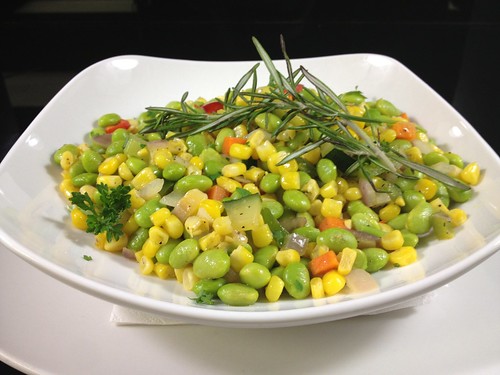One of the changes we made with the installation of the digital menus was to freshen up our side choices a bit. The first change was to offer sides that could be "shared." Each entrée will still be offered their choice of our usual selections, but the sides that are listed under our menu's "SIDE" page will always be served in a portion that is large enough for a group of 2 or 4 to share. If you see something there that appeals to you, but are afraid that your eyes might be bigger than your stomach, keep in mind that there will be plenty to pass around. I'm sure someone at the table would be willing to share.
Currently as a featured side dish, we are offering succotash. The dish is made with fresh sweet corn, edamame, red onion, zucchini, carrots, green and red pepper - a perfect late summer, early fall dish of fresh vegetables. Again, the plate truly is a meal in itself.
And, what is succotash you might ask? Well succotash is a dish that consists of corn, squash and bean. Those are the main ingredients, and the rest of the vegetables can be mixed and matched as needed to complete the dish.
In the mid-1800s during the Victorian era, there was a rejection of all profanity, and so the common people developed a wide variety of malapropisms to avoid swearing on Holy names. Soon, one could hear Cripes and Crikey replace “Christ” and Dangnabit replace “G*d damn it“ and Cheese ‘n’ Rice replace “Jesus Christ.” The phrase Suffering Succotash replaced “Suffering Savior.”
During the Great Depression, succotash was a very common meal for many families because it was such a cheap dish to create. Corn and beans are always relatively inexpensive. We are no different. Times may be better today, but you can still get this dish at a price that might rival the ERA of the Great Depression.


No comments:
Post a Comment